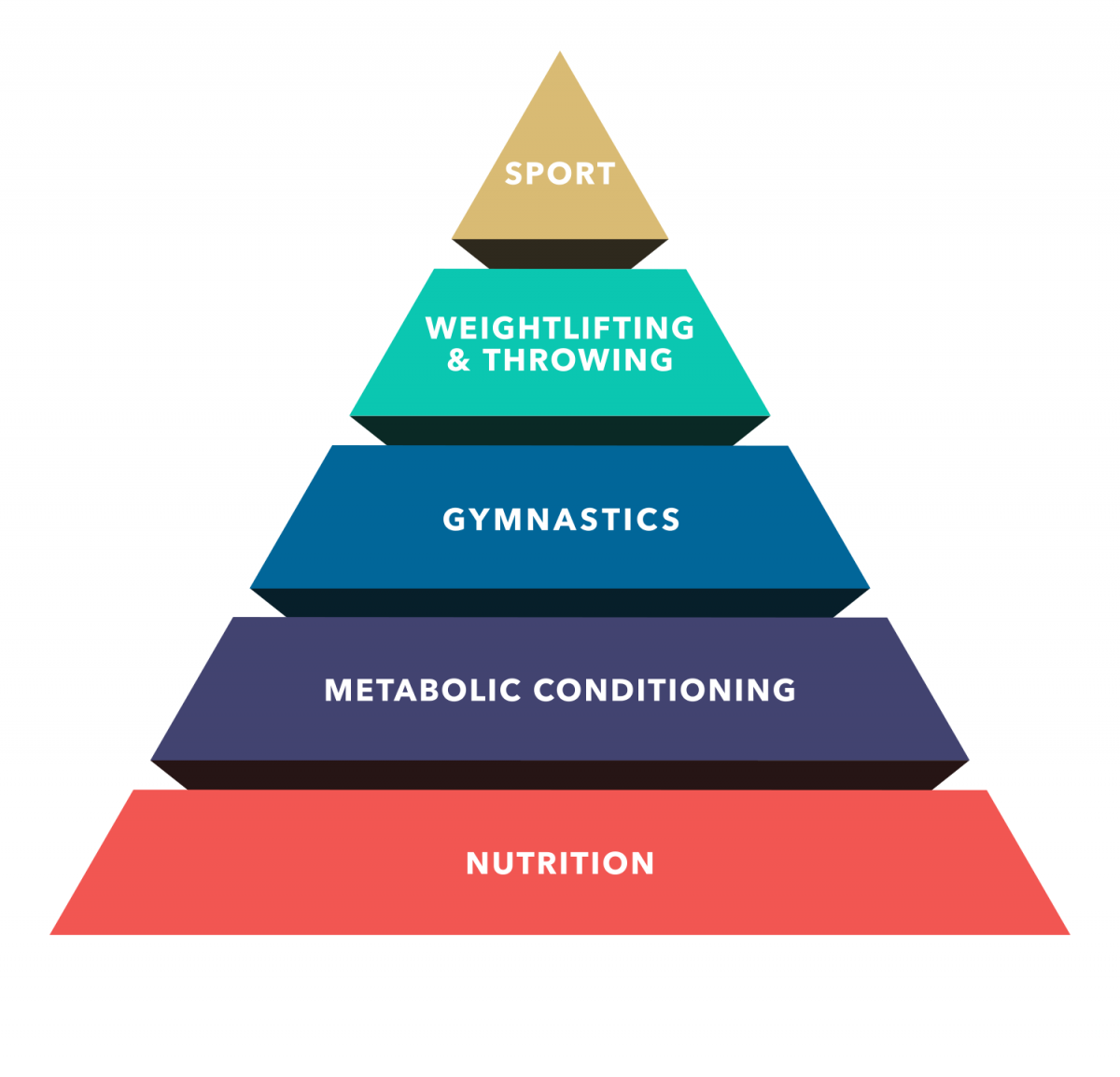“The Theoretical Hierarchy of the Development of an Athlete”
18/07/2022 # Training

“The Theoretical Hierarchy Of The Development Of An Athlete”
A theoretical hierarchy exists for the development of an athlete. It starts with nutrition and moves to metabolic conditioning, gymnastics, weightlifting, and finally sport. This hierarchy largely reflects foundational dependence, skill, and to some degree, time ordering of development. The logical flow is from molecular foundations to cardiovascular sufficiency, body control, external object control, and ultimately mastery and application. This model has the greatest utility in analyzing athletes’ shortcomings or difficulties.
We do not deliberately order these components but nature will. If you have a deficiency at any level of “the pyramid” the components above will suffer.
Every regimen, every routine contains within its structure a blueprint for its deficiency. If you only work your weight training at low reps you will not develop the localized muscular endurance that you might have otherwise. If you work high reps exclusively you will not build the same strength or power that you would have at low reps. There are advantages and disadvantages to working out slowly or quickly, with high weights or low weights, completing “cardio” before or after, etc.
For the fitness that we are pursuing, every parameter within your control needs to be modulated to broaden the stimulus as much as possible. Your body will only respond to an unaccustomed stressor; routine is the enemy of progress and broad adaptation. Do not subscribe to high reps, or low reps, or long rests, or short rests but strive for variance.
So then, what are we to do? Work on becoming a better weightlifter, stronger-better gymnast, and faster rower, runner, swimmer, cyclist is the answer. There are an infinite number of workouts that will deliver the goods.
Generally, we have found that three days on and one day off allows for a maximum sustainability at maximum intensities One of our favorite workout patterns is to warm up and then perform 3 to
5 sets of 3 to 5 reps of a fundamental lift at a moderately comfortable pace followed by a 10-minute circuit of gymnastics elements at a blistering pace and finally finish
with 2 to 10 minutes of high-intensity metabolic conditioning. There is nothing sacred in this pattern. The magic is in the movements, not the routine. Be creative.
Another favorite is to blend elements of gymnastics and weightlifting in couplets that combine to make a dramatic metabolic challenge. An example would be to perform 5 reps of a moderately heavy back squat followed immediately by a set of max-reps pull-ups repeated 3–5 times.
On other occasions, we will take five or six elements balanced between weightlifting, metabolic conditioning, and gymnastics and combine them in a single circuit that we blow through three times without a break.
We have not mentioned here our penchant for jumping, kettlebells, odd-object lifting, and obstacle-course work. The recurring theme of functionality and variety clearly suggests the need and validity for their inclusion though.
Finally, strive to blur distinctions between “cardio” and strength training. Nature has no regard for this distinction or any other, including our 10 physical adaptations. We will use weights and plyometrics training to elicit a metabolic response and sprinting to improve strength.
– CrossFit
Scalability and Applicability
The question regularly arises as to the applicability of a regimen like CrossFit’s to older and deconditioned or untrained populations. The needs of an Olympic athlete and our grandparents differ by degree not kind. One is looking for functional dominance, the other for functional competence. Competence and dominance manifest through identical physiological mechanisms.
We scale load and intensity; we do not change programs.
We get requests from athletes from every sport looking for a strength and conditioning program for their sport. Cricket, soccer players, badminton, tennis player, and boxers, and surfers all want programs that conform to the specificity of their needs. While we admit that there a surely needs specific to any sport, the bulk of sport-specific training has been totally ineffective. The need for specificity is nearly completely met by regular practice and training within the sport, not in the strength and conditioning environment. The soldiers, skiers, mountain bikers, and housewives have found their best fitness from the same regimen.
– CrossFit
Reference: CrossFit L1 Training Guide
